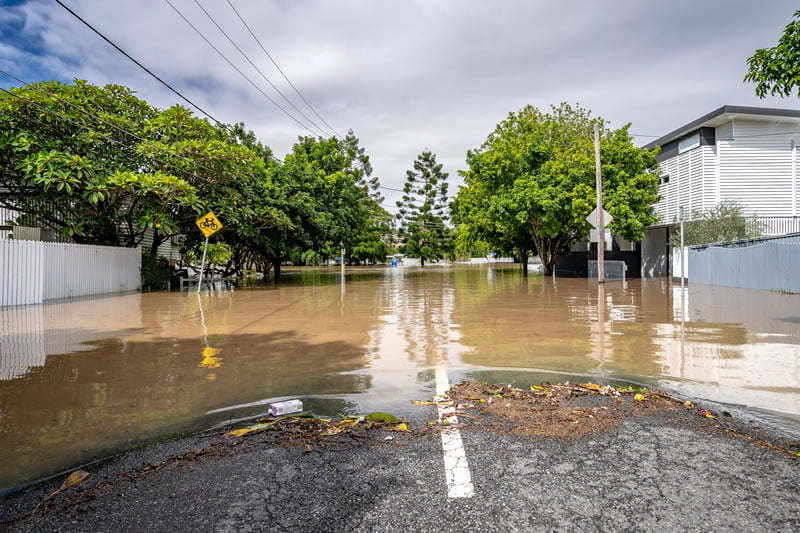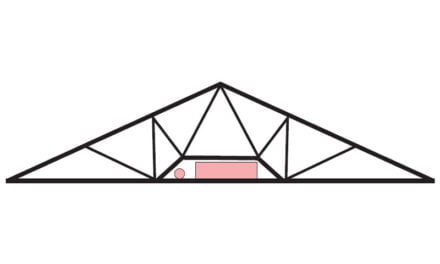With once-a-century floods now happening regularly, the industry and suppliers need to work with builders, developers and owners to help them make homes more resilient.
Shane Stone, the head of the National Resilience and Recovery Agency, can tell people they ‘shouldn’t be living among the gum trees’ till he’s blue in the face, but the reality of Australia is that housing in our capital cities is beyond the financial reach of millions and most of our regional cities are built in areas that are at risk from fire or flood. Sometimes both.
While there is legislation in place to protect homes from being built in at-risk areas, the real-world definition of what is at risk has changed dramatically since those areas were defined. Climate change seems to deliver record rain events and cataclysmic fires or winds most years now. And sea level rises continue to accelerate.
Unless a government is going to pay for individuals, housing developments or towns to relocate, most people will continue to own the block of land they own after a disaster and rebuild there if the zoning allows. So far – with an honourable exception for Queensland’s Grantham land swap response – no government, State or Federal, seems keen on the buyback option, despite expert modelling showing that it will be cheaper in the long term in multiple cases.
After too many recent natural disasters, recovery has been mostly left to individuals and their communities. Homeowners, their insurers (where homes can in fact be insured) and their builders have been left making decisions about what and where to build.
When it comes to fire, we have spent years helping people make material and design choices that dramatically increase their and their home’s chances of survival.
When it comes to flood, however, the message seems not to have come through as clearly. In NSW, the State Government only gave councils the power to halt developments in probable flood zones in May 2021. There are hundreds of thousands of properties across the state that are on ground at risk of flood over the coming decades and most of them are not built like classic Queenslanders.
We do know how to deal with this.
The Australian Building Codes Board updated Construction of buildings in flood hazard areas, ABCB Standard 2012.3, in 2019 (download at this link). While acknowledging that no building code will guarantee the survival of a structure in the worst floods, it outlines a straightforward set of guidelines for construction in flood zones. Similarly, the Queensland Development Code MP 3.5 (download here) covers construction of buildings in flood hazard areas.
The problem is that these guides rely on interpretation by the builder, who relies on what the developer or homeowner will – or is able to – pay. With housing costs soaring, it’s human nature these parties will try to keep additional expense to a minimum.
Unfortunately, climate change will not be keeping future disasters to a minimum.
It falls to us to present the best possible recommendations to our clients in ways they can use to deliver best possible rebuilds.
Design to survive
We’re not starting from scratch here. There are multiple expert reports out there with highly detailed information, including materials information and recommendations from major suppliers in our sector.
One of the more comprehensive guides to building in flood hazard areas was released in 2006, by the NSW Government – Reducing Vulnerability of Buildings to Flood Damage report (download it here).
It looks at design principles rather than giving prescriptions, so remains very pertinent 16 years later.
Citing the Hawkesbury-Nepean system as being particularly damaging to vulnerable flooding, it seeks to reduce the impact of floods on residents and the cost of post-flood repairs. Focusing on new builds and rebuild rather than attempting to retrospectively floodproof existing homes, the guidelines are predominantly for wet flood proofing: where it is accepted that water will move through many homes, but where that movement is designed to cause minimal damage to the structure and walls of the building.
As the introduction says, “Measures to reduce flood damage are more cost-effective at the design stage. The key aim is to minimise flood damage to the structural load bearing components of a building to prevent the structure from failing and leading to costly rebuilding or even demolition. Preferably, reinstatement of a flooded home should involve little if any content replacement, cleaning and minor repairs.”
It’s a long read, but it provides an excellent basic primer to designing for homes in flood-prone areas. Key points in the design guidelines include focusing on the sites of structures and watercourses within a property; structures that can withstand or (better) accommodate the pressure of flood waters, both laterally and as they rise; walls and cavities (including insulation) that dry quickly and thoroughly so as to minimise mould and rot; wall, floor and ceiling materials that do not lose structural integrity when wet; foundations that will withstand the force of the water; and, where possible, default two-storey designs to help protect belongings and residents.
While all these recommendations do add cost at the time of building, there is a clear, often dramatic, difference between additional cost at building time and remediation costs post-disaster. In every case modelled, the additional building costs were more than recouped, multiple times over in most.
Section 4.3 sets out parameters for building materials. Although the report doesn’t contain information for some materials that post-date its writing, there is still strong guidance when it comes to suitable choices and a range of price points are considered.
A point reiterated several times is that you can differentiate between components that should be made from flood-resistant materials (in particular floors and other structural components that are vital in keeping people and possessions safe in the house as well as expensive and difficult to replace) and those that can be sacrificial, such as internal cladding. Money can be saved on the latter if necessary, as they are comparatively cheap and easy to replace.
The report writers have adopted a pragmatic approach to materials, noting that economics will often dictate choices. While the prices in the document are well out of date, the engineering, geotechnics and design guidance remains sound and the styles of homes discussed are common throughout the Eastern Seaboard (though Queensland builders already have a strong focus on flood safety for the most part.)
Passing the test
Since the huge floods of 2011 (and in some cases before), major suppliers have been including flood risks and damage responses in the materials information they pass on to their customers. They have worked actively with clients, both directing materials choices and supplying detailed information on post-flood drying/remediation watchpoints.
Tilling and Meyer both provide extensive information about their joists, ply and LVL products, down to noting that horizontal surfaces in joists may require particular care as silt can accumulate there after a flood.
As they say, some products are only recommended for areas where any inundation will quickly recede – usually within a few days and certainly not more than two weeks – while others are able to withstand more extensive immersion.
One example of the latter is the Foreverbreathe Demonstration Home, which was built close to Flockton Basin, a flood-prone part of Christchurch, NZ, where the city has been trialling flooding responses, including barriers and pumping stations.
“We were deliberate in our approach,” says Robin Curtis, co-founder of Health-Based Building (see ‘Breathe easy’ in TTN Jan 2022). “Because there are a lot of geographical issues for homes here, it’s a good location for a company like ours that’s trying to prove the worth of a construction system.”
In response to the site, the house is built on MicroPro-treated timber piles, rammed 5m into the ground, “This raised the house at an affordable cost,” Curtis says. “We also incorporated concrete around the piles, which meant we minimised our concrete use, but provided resistance to land slippage above the house.”
In the home itself, Magnum Board is used widely as a rigid air barrier, lining, flooring, ceiling and cladding material. A high-quality, high-density magnesium oxide board, it’s a key part of Curtis’s building system, along with wool-based insulation.
“This is a massive step forward for houses in flood-prone areas,” he says. “After a flood, when the insurance company comes through to recondition the house and dry it out, they remove everything that needs to go and bring in industrial driers so the house can be rebuilt and people can return home. Usually that means ripping out the plasterboard, because of mould issues and damage if anything is pushed into it while its wet, and fibreglass insulation, which fails when it gets soaked.
“Using the products we use in our system, the interior wall linings, rigid air barriers and claddings don’t need to be ripped out or replaced because the products have this ability to be submerged in water for reasonable periods of time and will dry out fully with no loss of performance.”
Importantly, the wool insulation in Curtis’s system retains performance and will dry out in situ (“Sheep are drip-dry,” he quips). With a permeable coating, Magnum Board allows moisture that has come into the walls to evaporate, thus drying the frame inside, so there’s no need to pull out linings or other areas where the board is used. It also won’t grow mould, “so the health risks from damp buildings that often follow floods and which can last years don’t arise,” says Curtis.
A key distinction between Curtis’s demonstration build and the standard Aussie home is the framing. “In Australia, we’re mostly using H2 treated timbers, which can have poor durability once wet if the water stays around for more than a fortnight or if they’re not dried properly,” says Glenn Lawrenson of McCormacks Australia. “In New Zealand, frames and studs are more commonly hardwood, treated to hardwood-like durability or heavier steel, so there’s less urgency when it comes to drying them out. But there’s nothing stopping the Australian customer using framing timbers with a higher treatment level that can stand up to more of a soaking. The MicroPro Robin used on the Demonstration Home goes up to H4 and H5, so will cope with permanently wet soils and is pretty safe, too.
“The other major problem people have is with their insulation, which is why we like Robin’s system. Especially because there’s not a massive difference in the price points between his system and a standard build.”
Lawrenson notes that in most cases, standard timber frames are able to survive an inundation, especially when waters retreat quickly and the frame can be dried in a steady and timely way. Problems arise when soaking is prolonged or when high levels of silt are caught inside the frame.
Curtis points out that insurance companies have driven changes to building codes around the world in response to repeated disasters. “This may well be the next thing they look at. Drying the frame of the house is the most important aspect of recovery. That’s why the first step at the moment is usually to pull out linings, even when they haven’t failed; they’re trying to get to the frame and to rip out the insulation and then bring in the driers. You need that for untreated or H2 timber or light-gauge steel.
“But now the building codes in disaster-prone areas like Florida and California are changing. The first choice is evacuating areas like this, but if there’s no financial support, most people can’t manage that. And many people don’t want to: they like where they live. The next line of defence is changing your house design styles – raising your foundations – and also using building materials that will cope with inundation with just a hose-out required. The materials need to dry out quickly, to not grow mould and to be healthy and liveable for people moving back in, not slowly rotting as so many of the houses in Florida are.”
Curtis flags that financial interests will quickly drive changes to how we build. “Because it’s not just happening in places with cheaper housing like Lismore; it’s the Brisbane River, it’s parts of Sydney,” he says.
“Once you start looking at million-dollar-plus homes, which is a lot of major Australian cities, that’s huge exposure for the banks and the insurers. They’re going to insist on building codes that recognise there are better ways to build. The problem we have now is that the only people having those conversations are at the more elite end of building, usually top-end designs with architects involved. We need a more industry-wide approach, to have a conversation we’re all involved in.”
He worries that if the decisions are left up to various levels of government, then the solutions will be ones that are exciting but not necessarily effective. “When we were developing our system, we looked at a lot of places that had similar problems to what we face in New Zealand,” Curtis says.
“Florida was one: they have spent billions on pumping systems to protect their cities, and they just can’t keep up with the worsening effects of climate change. So now they’re focused on materials that will survive the disaster events they have, and they’re changing their standards to reflect that.
“You may still need to lose your carpet and your kitchen cabinets to dry your house back to the 18% moisture levels required to re-sheet it, but you keep a lot more, so it’s faster and cheaper to recover.”
After the rains
When this story was first written in mid-March, the rain had finally stopped and waters were going down across NSW and Queensland. Between going to print and the story appearing online, another flood inundated the Northern Rivers. While the NSW and Qld governments are working together to assist, affected locals are exhausted and many are still waiting for insurance assessors weeks after the first damage.
In the immediate aftermath, even before the water and mud clears, there are resources readily available to help owners make decisions about what is and what is not recoverable. In most cases and virtually 100% of situations involving safety or salvaging major parts of a home, even at the expense of, say, cladding or lining, insurers and grants bodies have readily accepted photos or other documentation when a timely official inspection is not possible, allowing owners or local contractors to start work on getting back into homes asap. Call your insurer first if possible, otherwise document the situation as fully as you can.
Major suppliers including Meyer and Tilling have produced detailed guides for their branded product and have engineers on board who are well-placed to give specific advice, from recommendations for drying to watchpoints around silt and moisture collection on EWP.
There are also excellent technical guides available from Industry bodies, with specific advice for assessment and repair. Timber Queensland updated their Guide to Assessment and Repair of Flood Damaged Timber and Timber-Framed Houses in February this year. It includes a comprehensive series of easy tests to determine the damage done by rot and some valuable photo assistance in a guide that’s short enough to flick through on your phone onsite. The list of handy links at the end includes a recommended moisture meter to guarantee your timbers have returned to <18% moisture (the Delmhorst J4 with sliding hammer electrode if you’re buying).
WoodSolutions Design Guide 12, Impact and Assessment of Moisture-affected Timber-Framed Construction covers much of the same ground as the Timber Queensland guide in its flood-based Chapter 2, but has more details on general wetting and coastal tidal surges elsewhere.
Additionally, this guide contains two appendices to direct the user through moisture testing, outlining the moisture content ranges of various timber products under Australian Standards, methods of measurement and both the use of and limitations of resistance and capacitance meters, plus where each method is best deployed or avoided.
WoodSolutions also ran a free Zoom event titled Resources for Recovery: Post-Flood Assessment and Repair on March 24, featuring a panel of experts from Timber Queensland. It will be available to view on the WoodSolutions Webinars page.
The appendices of the Hawkesbury-Nepean report also contain a simplified explanation of hydrostatic and hydrodynamic forces, which may be helpful in determining whether some damage is likely to be structural or cosmetic and so help local builders and engineers when it comes to triaging structures that can be rebuilt safely.
It will never be possible to save everything, but by focusing on likely risks from natural disasters whenever we build, we can design and construct homes that are more able to withstand them. From the style of house to its materials, to detailing like solid doors and hopper rather than sash windows, we can deliver homes that will be more likely to survive floods (and – most importantly, more likely to retain enough structural integrity to keep the people within or on top of them safe until help arrives) and cost less to rebuild after the disaster passes.
Even simple changes like installing kitchen cabinets on legs (with or without removable kickboards) that add height and ventilation will be enough to save some kitchens from ending up on the nature strip.
“We can’t keep ripping houses apart every time these events occur,” Curtis says. “And that’s not just because we’re going to keep having major events, it’s because our supply chains on many products are becoming more tenuous and less profitable. In New Zealand, if we get yet another catastrophic event on the West Coast, and we’ve just had two, we don’t have the materials. Those mainstream products don’t exist in this country in quantities that let you rip them off every time they get wet.
“It’s very similar in Australia. That’s an important aspect of what we’re looking at: it’s not just making life easier for the people living in these areas, we’re building resilience into the building sector.”
For more details, visit www.healthbasedbuilding.com.au, www.meyertimber.com.au and www.tilling.com.au.












